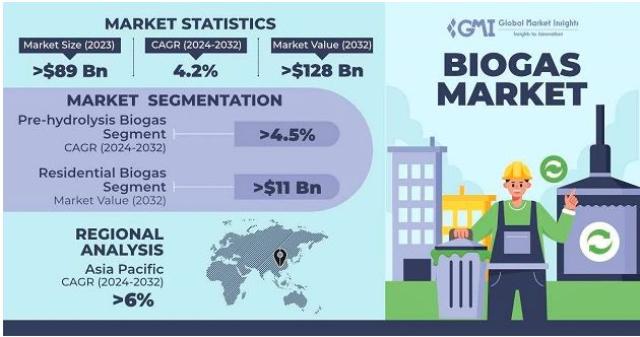The biogas market is anticipated to register a CAGR of over 4.2 percent between 2024 and 2032, according to GM Insights.
Many governments have implemented supportive policies, such as subsidies, tax incentives, and renewable energy targets, to encourage the adoption of biogas technology. Additionally, growing awareness of the environmental impacts of fossil fuels and the need to reduce greenhouse gas emissions has fuelled the demand for biogas as a clean and sustainable alternative.
The Dubai Municipality has made significant investment in a biogas plant at the Warsan sewage treatment plant aiming at decreasing carbon dioxide emissions. This project is guided by the Dubai Clean Energy Strategy 2050.
In May 2022, the UN-Energy Plan of Action Towards 2025 delivered on commitments made at a high-level meeting, which laid out a global roadmap for energy access and transition by the end of the decade, while also contributing to net zero emissions by 2050.
Innovations in anaerobic digestion technology, such as improved digester designs and process optimization, have increased the efficiency and scalability of biogas plants. Moreover, the integration of biogas production into waste management systems has gained importance as a sustainable solution for organic waste treatment. As industries and municipalities seek cost-effective and eco- friendly waste disposal methods, biogas technology emerges as a viable option, further driving market expansion.
Food and beverage industries in Europe are investing in the management of food waste to attain a zero-waste economy. Companies such as Nestle, PepsiCo, and Unilever have started directing some food waste to biogas production to generate power for manufacturing units. In fact, Europe accounted for 41.81 percent revenue share of the overall market for biogas in 2021.
Biogas industry is segmented based on substrate, size, technology, process, application, and region.
Sewage sludge segment will record a notable growth through 2032, favored by the increasing need for sustainable waste management solutions. With growing urbanization and wastewater treatment requirements, sewage sludge presents a readily available and abundant resource for biogas production. Additionally, advancements in anaerobic digestion technology have improved the efficiency and feasibility of converting sewage sludge into biogas, making it an attractive option for municipalities and wastewater treatment plants seeking to reduce disposal costs while generating renewable energy.
Commercial & industrial segment is slated to generate notable revenues during 2024-2032, owing to focus on prioritizing sustainability and reducing the carbon footprint. Moreover, the economic benefits of biogas, including potential cost savings on energy bills and opportunities for revenue generation through incentives or renewable energy certificates, make it an attractive investment for commercial and industrial entities.
Europe biogas industry will record a notable growth through 2032, attributed to stringent environmental regulations and renewable energy targets. Additionally, a robust framework of subsidies and incentives encourages the development of biogas projects. Technological innovations & collaborations facilitate continuous advancements in biogas production efficiency and grid integration. Lastly, increasing public awareness of climate change and the need for sustainable energy sources will stimulate the regional industry expansion.

